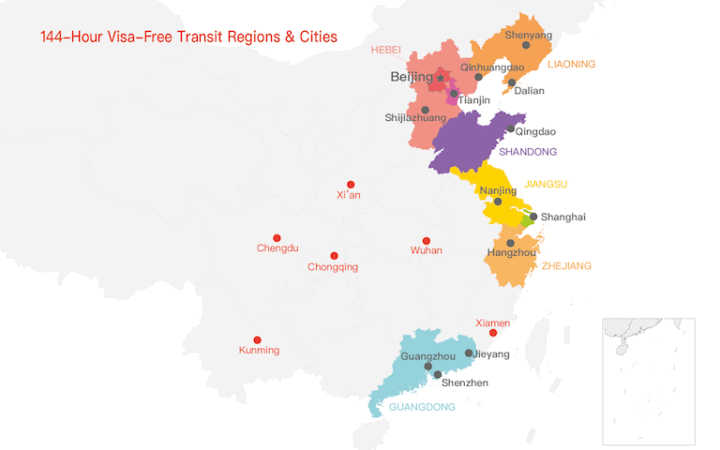How to Transit Through China for 144 Hours Without a Visa
New policy: From December 1, 2023, to November 30, 2024, you can revel in a visa-free entry for 15 days for tourism, business, transit, or visiting friends and family. This is up for grabs if you hold a passport from one of the fantastic six – France, Germany, Italy, the Netherlands, Spain, or Malaysia.
Content Preview
China implements a 144-hour transit visa-free policy, allowing travelers to enter the port-of-entry city (port-of-entry city) and freely move between covered cities in the region (region-covered cities) within a period equivalent to 6 days. Moreover, travelers are permitted to depart from any city within the covered region.
(port-of-entry city):
Shanghai, Hangzhou, Nanjing, Beijing, Tianjin, Shijiazhuang, Guangzhou, Shenzhen, Chengdu, Xi’an, Dalian, Shenyang, Xiamen, Chongqing, Kunming, Wuhan, Kunming etc.
(region-covered cities):
Yangtze River Delta region: Shanghai, Jiangsu Province (main cities: Nanjing, Suzhou), Zhejiang Province (main cities: Hangzhou, Ningbo)
Beijing-Tianjin-Hebei region: Beijing, Tianjin, Hebei Province (main cities: Shijiazhuang, Qinhuangdao)
Guangdong Province: Shenzhen, Guangzhou, Zhuhai, etc.
Chengdu area: Chengdu, Leshan, Ya’an, Deyang, Suining, Meishan, Ziyang, Zigong, Yibin, Neijiang, Luzhou
Xiamen City only
Chongqing
Xi’an, Xianyang
Wuhan City only
Kunming City only
Liaoning Province: Shenyang, Dalian, etc.
Shandong Province: Qingdao, etc.
Cities eligible for the 72-hour visa-free transit but not qualifying for the 144-hour visa-free transit: Qingdao, Changsha, Harbin, Xiamen, Guilin,
For example, you can travel from Shanghai to Nanjing, as they are both part of the Yangtze River Delta region. However, traveling to Beijing is not permitted, as it belongs to the Beijing-Tianjin-Hebei region.
Does my itinerary comply with China’s 144-hour transit visa-free policy?
If you want to benefit from the 144-hour visa-free transit policy in China, here are the key requirements:
1. Hold a passport from one of the specified 53 countries/regions, valid for at least 6 months.
2. Possess a connecting flight ticket departing from mainland China within 144 hours.
3. Complete the arrival and departure cards.
4. Travel toward a third country or region (including Hong Kong, Macau, and Taiwan).
5. Obtain any required visas for the third country/region before departure.
6. Enter the visa-free zone using train, ferry, or airplane.
7. No intermediate stops within mainland China before or after the entry port.
8. Layover time must not exceed 144 hours.
9. Stay within the allowed area; no travel outside this area is permitted.

Here’s a quick test to check if you comply with the policy:
Quick Test: Will My Route Qualify for China 72/144-Hour Visa-Free Transit?
Result:
You qualify to enjoy China's 72-hour visa-free policy.
You qualify to enjoy China's 144-hour visa-free policy.
You don't qualify to enjoy China's 72-hour or 144-hour visa-free policy.
Reason you don't qualify:
- You must be in transit to a third country or region.
- You must leave the city area (prefecture or municipality) after the 72/144 hours (the 72/144-hour limit is calculated starting from 00:00 on the day after arrival, i.e. 24:00 on the arrival date).
- Your passport nationality is not eligible for the 72/144-hour visa exemption program.
Important notes:
1. You are only allowed to remain within and depart China from Beijing.
2. Your passport must be valid for more than 3 months at the time of entry into China.
3. You dont't have Chinese visa refusal stamps in your passport.
4. Please bring your China hotel reservation in case it is needed at the time of entry into China.
More questions please feel free to contact us.
The 144-Hour Visa-Free Transit Policy covers nationals from the following countries:
Americas (6): United States, Canada, Brazil, Mexico, Argentina, and Chile
Europe (39): Austria, Belgium, Denmark, Czech Republic, Estonia, Finland, France, Germany, Greece, Hungary, Iceland, Italy, Latvia, Lithuania, Luxembourg, Malta, Netherlands, Poland, Portugal, Slovakia, Slovenia, Spain, Sweden, Switzerland, Russia, United Kingdom, Ireland, Cyprus, Bulgaria, Romania, Ukraine, Serbia, Croatia, Bosnia and Herzegovina, Montenegro, North Macedonia, Albania, Belarus, and Monaco
Oceania (2): Australia and New Zealand
Asia (6): South Korea, Japan, Singapore, Brunei, United Arab Emirates, and Qatar
How to Utilize the 144-Hour Visa-Free Transit Policy to Enter China?
Visitors under the 144-hour visa-free transit policy have a dedicated channel, easily accessible upon disembarking. Following the signage, you’ll need to fill out required forms and present documents, mainly your onward ticket to a third country, confirmed hotel reservations, and your passport. Subsequently, you’ll receive the designated entry permit.
Five Steps for 144-Hour Transit:
Inform your carrier about your plan to use the 144-hour TWOV and secure your onward ticket when boarding.
Complete Arrival and Departure Cards provided during the flight.
At the dedicated 144-hour visa-free transit counter upon arrival, submit required documents.
Collect luggage, clear customs, and exit the airport as with visa processing.
Depart from the designated port before midnight on the sixth day, submitting the completed departure card at immigration.
How is the 144-Hour Period Calculated?
Your 144-hour stay starts at 00:00 on the day following your entry. For example, if you arrive in Shanghai at 6:00 AM on June 1, your 144 hours begin from 00:00 on June 2, allowing you to stay until 23:59 on June 7. Note that specific airports may have their own rules for calculation, so check in advance.
Differences between 24-hour, 72-hour, and 144-hour transit visa-free.
Mainland China’s Transit Without Visa (TWOV) program has three options: 24-hour, 72-hour, and 144-hour. The significant difference lies in the 144-hour policy, allowing travelers to move within three designated regions instead of being restricted to a single city or specific area.
| 24-hour | 72-hour | 144-hour | |
|---|---|---|---|
| Countries covered | almost all ethnic groups | 53 nationalities | 53 nationalities |
| Port of entry citys | Most cities in China | 18 cities | Shanghai, Nanjing, Hangzhou, Beijing, Tianjin, Xi'an, Chengdu, Chongqing, Dalian, Shenyang |
| Arrivals and departures | Can pass different ports | Must come from the same port | Can pass different ports |
| Transportation | Plane, ship or train | By air | Plane, ship or train |
| Mainland China travel | Only in transit areas | Only within city limits | Limited to the area where the port of landing is located |





Comment (0)